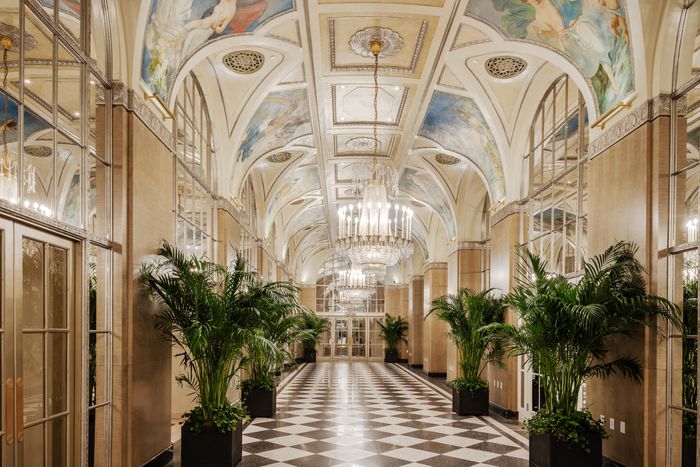The renovation of the hotel’s public spaces has been widely lauded. The project also went way over budget and took five years longer than expected.
Photo: David Leventi
The Waldorf Astoria reopened this summer after an extensive renovation that went five years over schedule and apparently a billion dollars over budget, The Wall Street Journal reported this week. The Art Deco hotel’s much-delayed renovation has been a subject of interest and speculation as it dragged on over the years, after the hotel was purchased by the Chinese insurance giant Anbang for $1.95 billion in 2014. Many New Yorkers feel a connection to the Waldorf, one of the last grand hotels that hadn’t yet been converted to condos, with its vast, ornate public spaces where anyone could get a drink or use the bathroom.
Some reasons for the delays are well known: Anbang’s founder, Wu Xiaohui, was sent to prison in 2017 during a crackdown on foreign investment, and the Chinese government took over the project; then came COVID and the kinds of delays that may be expected when renovating a nearly 100-year-old building and converting a big chunk of it into condos. But other details of the renovation saga have not been publicized until now. Below, a few of the choice details from the Journal’s story about what took so long and why it all cost so much.
1. Brokers told the real-estate executives handling the Waldorf sale that it was worth only a little over $1 billion, but they decided to ask Wu for nearly twice that during a business breakfast at the Peninsula Hotel. They were shocked when he more or less said “yes,” countering their $2 billion ask with a $1.9 billion offer. By the end of the day, they had a handshake deal for $1.95 billion.
2. Amazingly, Wu thought he’d gotten a deal. “Such a lifetime ownership of this trophy hotel is very cheap in my eyes,” he said at a 2015 Harvard event, noting that “the hotel was 163,000 square meters, so on a square-meter basis the purchase was less than certain properties auctioned off in Beijing’s financial district.”
One of the many historical landmarked areas of the hotel that required meticulous (and expensive) renovation.
Photo: David Leventi
3. Wu initially wanted to complete the renovation and conversion of the landmarked building in just a year. According to the Journal, “He reminded his team of planners and construction executives that the Empire State Building had been completed in little more than a year. He wanted the Waldorf renovation to be just as quick.” They pointed out that labor had been cheap and plentiful during the Depression and that kind of turnaround was impossible given modern labor laws and safety standards. Wu “grudgingly” agreed to a three-year timeline, with the renovation starting in 2017.
4. Wu reached out to prominent New York developers about partnering on the project, including the Zeckendorfs, but Will Zeckendorf “got the impression that Wu was more interested in extracting ideas and local knowledge than in entering a genuine partnership,” reported the Journal. Later, he learned that “Wu intended to lead the project on his own.”
5. Wu had “visions of a glorious new era for the Waldorf” and told the renovation team he wanted to create a “private club in the Waldorf that would admit only the city’s billionaires,” according to the Journal. He also considered “transforming the grand ballroom into a private gym for residents that would turn into a nightclub in the evening.” The ballroom, thankfully, is still one of the public spaces in the hotel, not a private gym.
6. At the property’s grand reopening (now scheduled for November), Wu had wanted to hold “a ball for VIPs, where holograms of ancient Chinese warriors would enter the hotel followed by similar images of former residents Sinatra and Marilyn Monroe emerging from a black limousine,” said the paper. He also wanted the (real) Céline Dion to perform. Of course, all of Wu’s grand visions ended with his arrest.
7. The cost of construction is now expected to exceed $2 billion — about $1 billion more than initially thought. Some of the cost went to the restoration of exquisite period details, such as the lobby clock, murals, and the floor mosaic up the grand staircase to the lobby, which involved 148,000 pieces of hand-cut marble tile — work overseen by Skidmore, Owings & Merrill. But a lot of it was basic building repair that was more extensive than expected: replacing windows, plumbing, electricals, and elevator shafts, which had to be built entirely anew, along with the stairs. Some insiders speculate this might have been the costliest real-estate conversion in the United States.
The hotel’s public spaces and some rooms opened this summer, and it’s expected to open fully next month. The condo portion is partially complete, with the first closings happening in December of last year.
